Review of 98 single board computers. Part 1
Part 1
Part 2
Part 3
Part 4
From the translator: I bring to your attention the translation of the report on single-board computers, which was published on LinuxGizmos.com. The report includes brief descriptions of 98 boards worth up to $ 200. In the report, these boards are called "hacker" to emphasize their suitability for various creative works.
Since the amount of information is very large, I have broken the translation into several parts.
I also want to warn you that there are a lot of pictures under the cut!
So part 1.
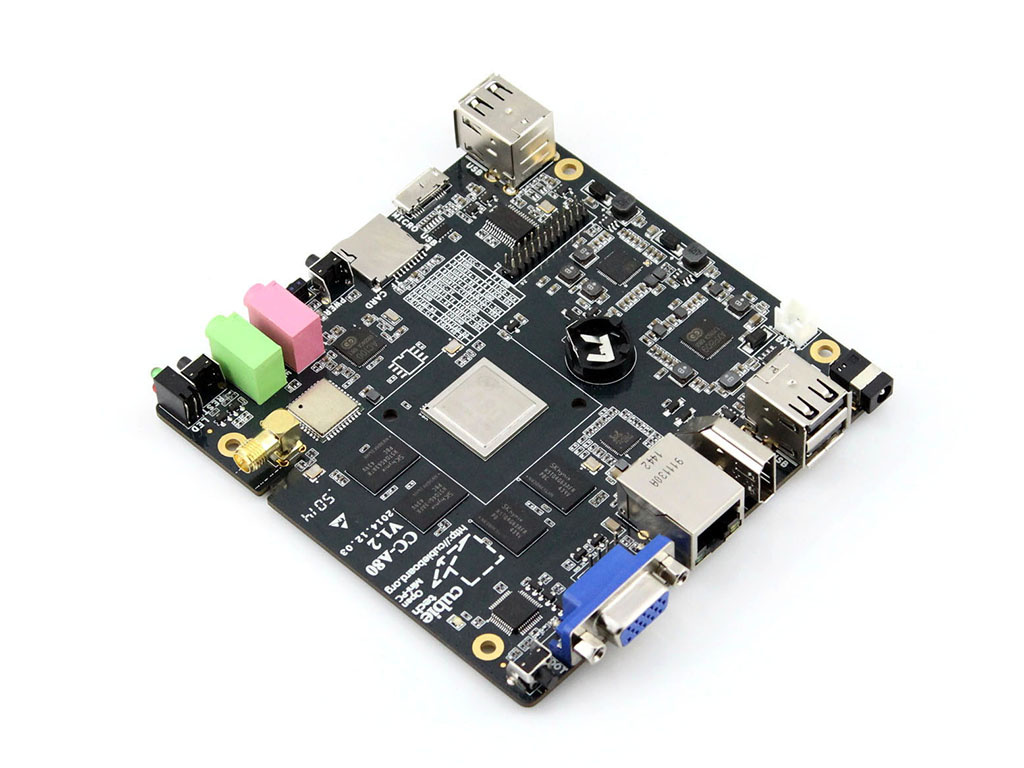
KDPV
Over the past year, LinuxGizmos has reported dozens of new single-board computers with open specifications, friendly to developers and “hackers,” on which Linux and Android can run. We added them to our catalog along with the old boards. The fees in our review cost less than $ 200 excluding shipping, are available for delivery in July of this year, and meet our (very flexible) openness criteria.
The catalog was compiled in collaboration with the Linux.com community of the Linux Foundation.
In addition to 98 reviews, we have compiled a detailed table for comparing the basic parameters of all 98 boards.
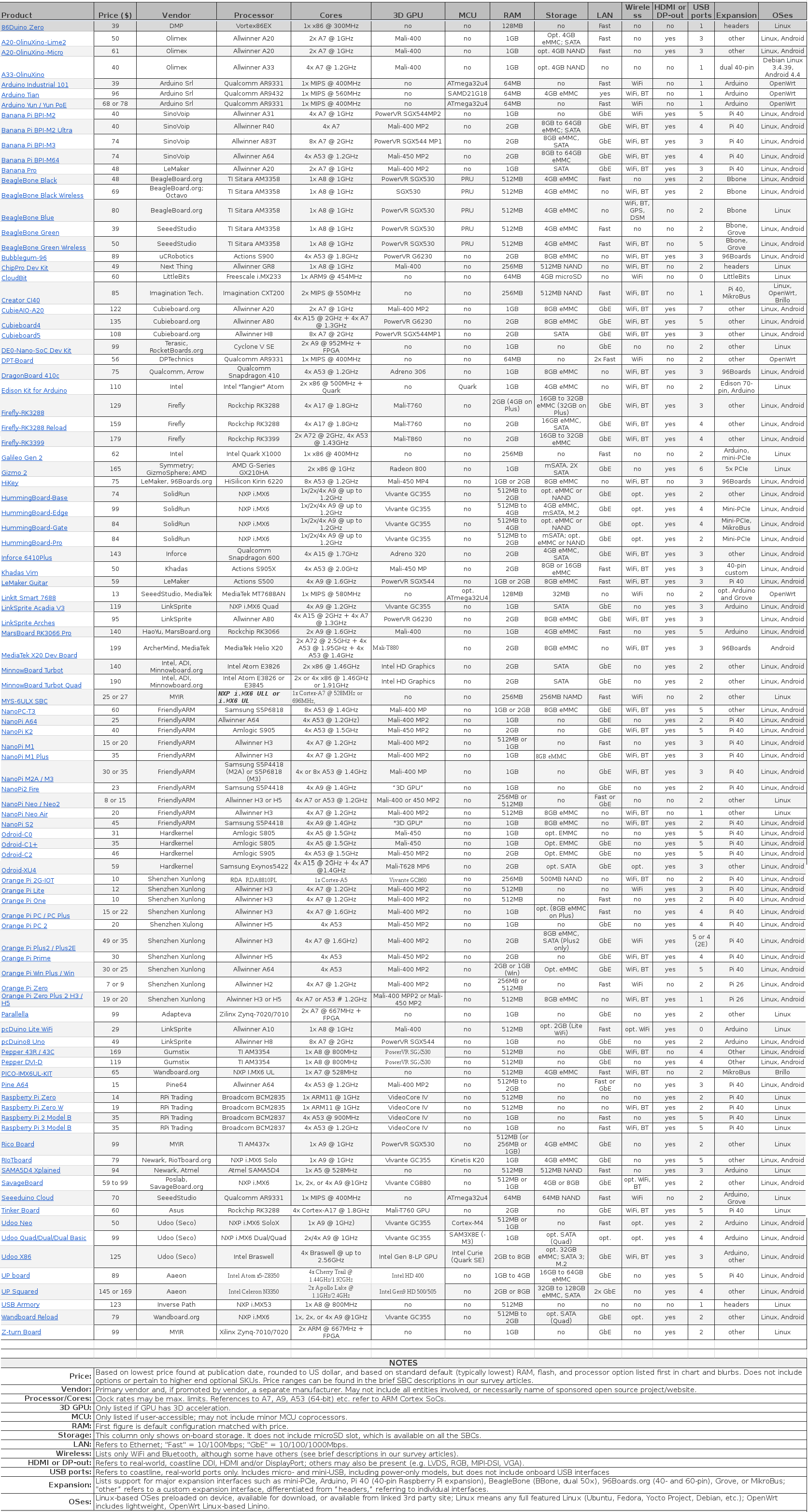
Summary table of all the boards in the review. To view, open the image in a new tab.
This list expands our January catalog of 90 single-board computers. In June 2016, the catalog included 81 fees, in May 2015 - 53 fees.
Selection criteria
Determining the selection criteria for single-board computers with open specifications is not an easy task. None of the single-board has completely open source, especially for the GPU and sometimes poorly documented CPU, however, the RISC-V architecture can make a difference in the near future. Some boards from our list have a fully open-source hardware license. Finally, the project must provide detailed specifications and diagrams of at least I / O ports for connecting additional expansion cards. Projects should also at a minimum have technical support and a community for individual developers, that is, forums, tutorials, and other resources for publishing solutions and projects on this single-player platform.
For most buyers, it is important that Linux or Android distributions with board resource support are available for download. For new boards, we allow some delay in this matter.
The overview below includes a brief description and specifications for each board, with links to the respective manufacturer's pages.
Prices are the lowest at the time of publication, but the price of many boards may vary. Prices do not include shipping, or include free shipping only to certain regions. Sometimes the cost of shipping can be substantial, making, for example, a $ 35 fee into a $ 50 fee. Since LinuxGizmos has an international audience, we do not include shipping in the price.
We welcome user comments, especially support and software. Please participate in the discussion after the post. Do not forget to vote for your favorite "hacker" fee.
The overview lists the fees in alphabetical order, and is based on specifications and lowest available prices for the last week of May 2017, fees are available for delivery in July 2017.
86Duino Zero
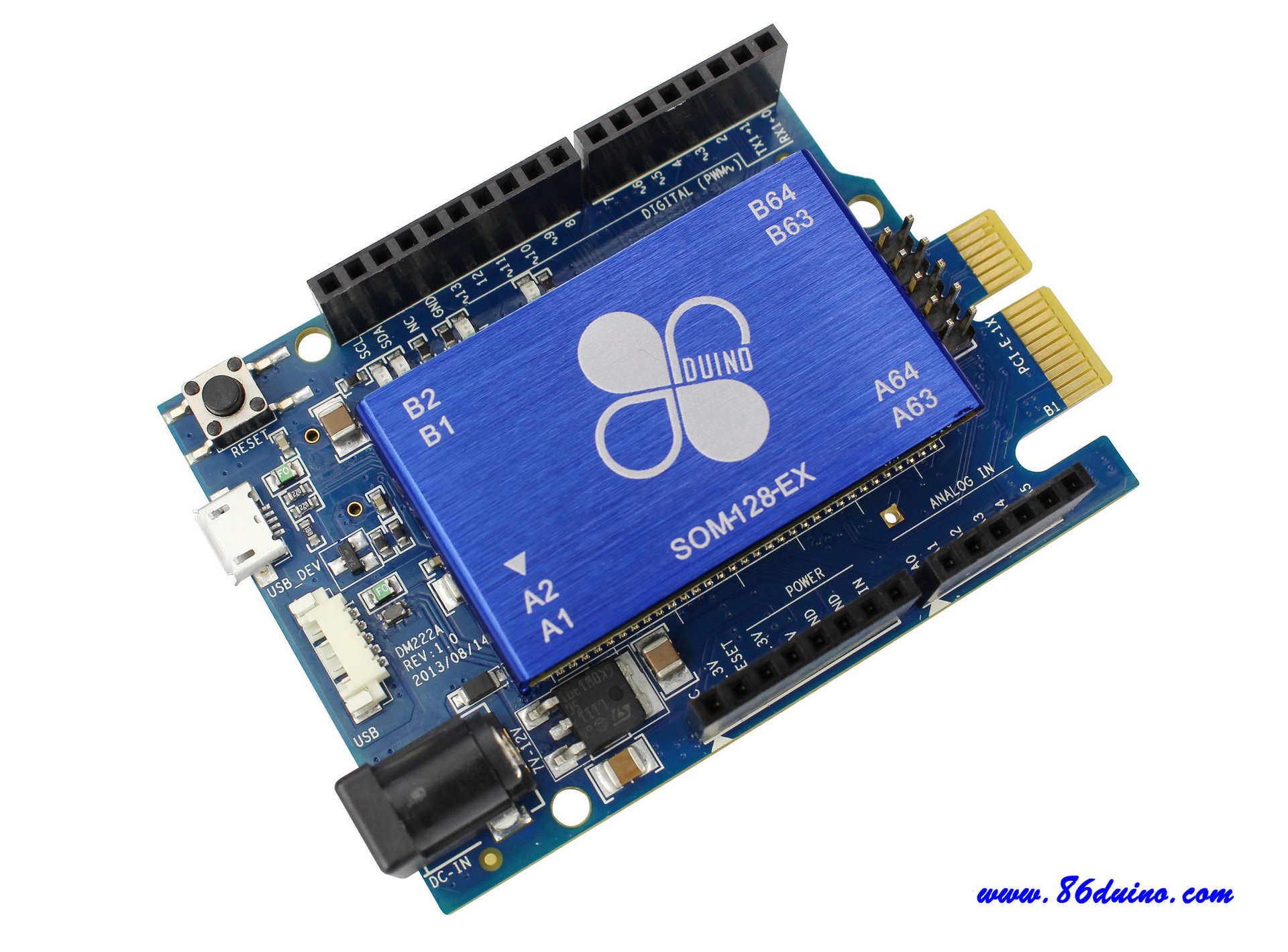
Company / Project - DM & P, 86Duino.com
overview from linuxgizmos
Product page
CPU - DM & P Vortex86EX (1x x86 @ 300MHz)
Memory - 128MB RAM
Price - $ 39
The 86Duino board on the DM & P processor is one of the smallest x86 single-board devices, comparable to 102 x 53mm for the One model. The board is compatible with Arduino expansion slots, has low power consumption, and a modular design. Includes Fast Ethernet, USB 2.0, and microSD connectors, 17 digital I / O ports, and 6 analog inputs. Model One for $ 69 also has HD audio and more ports. There is also a mini-PC version of the EduCake and a version of the One SeeedStudio model. Currently, the project is not developing, the activity on the forum is low.
A20-OlinuXino-Lime2

Company / Project - Olimex, OlinuXino, Mouser
Product page
CPU - Allwinner A20 (2x Cortex-A7 @ 1GHz); Mali-400 GPU
Memory - 1GB DDR3 RAM; optional 4GB eMMC version
Price - $ 50 (45 euros); $ 61 (55 euros) for the 4GB version
OlinuXino is a project of the Bulgarian company Olimex, one of the oldest projects of “hacker” boards, however, the company has recently focused on the open-source, but not Linux-compatible ESP32 platform. Much activity on the oLinuXino forum concerns boards on Linux, and earlier this year the open-source project of the Teres-A64 Linux-laptop set based on the Allwinner A64 processor for 225 euros started. Despite this, the old A20-OlinuXino-Lime2 is still interesting, it has a Gigabit Ethernet port (GbE, or 10/100 / 1000Mbps), a microSD slot, an HDMI port, an LCD interface, 3x USB ports, battery support, and 160 ports GPIO. The board has a size of 84 x 60mm, Android 4.2.2 or Debian Jessie operating systems with Linux 3.4.1 kernel. This year, Lime2 switched to the same revision of the board as Lime2-4GB / eMMC, which has an RTL8211E Ethernet PHY, connected to the board's ground mounting holes, a straight-line contour without cuts.
A20-OlinuXino-Micro
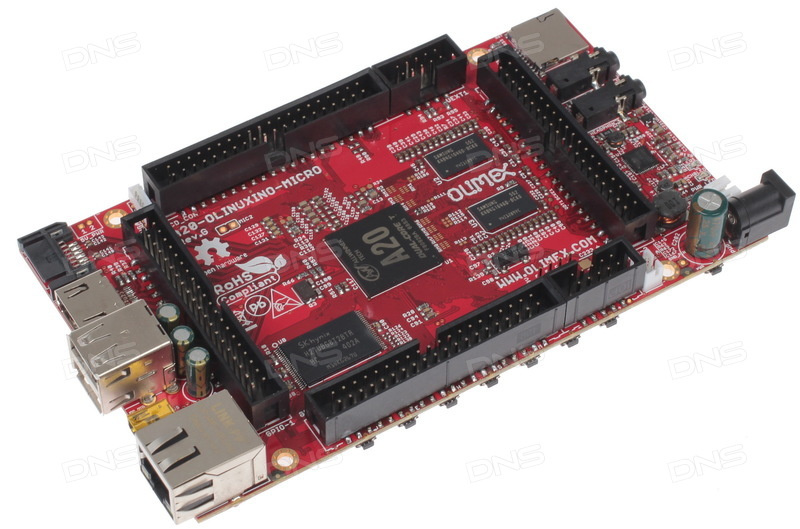
Company / Project - Olimex, OlinuXino, Mouser
overview from linuxgizmos
Product page
CPU - Allwinner A20 (2x Cortex-A7 @ 1GHz); Mali-400 GPU
Memory - 1GB DDR3 RAM; optional 4GB NAND
Price - $ 61 (55 euros); $ 72 (65 euros) for the 4GB version
The A20-OlinuXino-Micro has all the same ports as the first Lime model, plus the VGA, sensor-enabled LCD, and audio I / O. The larger board, 142 x 83mm, has connectors for connecting expansion modules. There is a version with 4GB NAND.
A33-OlinuXino
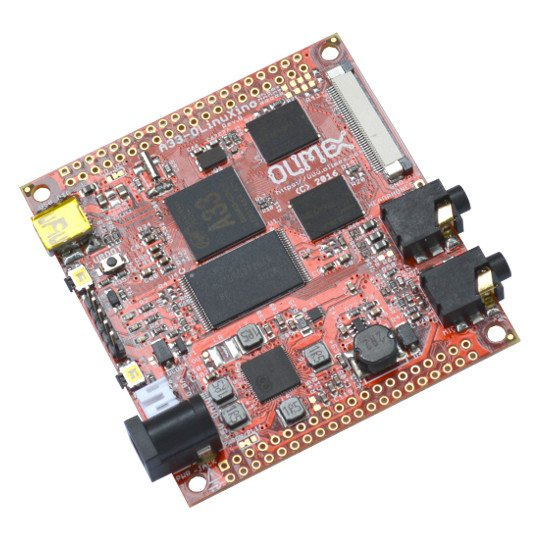
Company / Project - Olimex, OlinuXino, Mouser
Product page
CPU - Allwinner A33 (4x Cortex-A7 @ 1.2GHz); Mali-400 GPU
Memory - 1GB DDR3 RAM; there is version 4GB NAND
Price - $ 40 (36 euros) or $ 49 (44 euros) for the 4GB version
The A33-OlinuXino board has the fastest quad-core SoC Allwinner A33, compared to earlier OlinuXino boards, but a more modest set of everything else. Only mini-USB OTG, audio with a 100dB codec, and a 5V power connector are left from the ports. Two spaces for 40-pin GPIO connectors (not sealed), and 1280 x 800 LCD interfaces and dual MIPI-CSI cameras (5 and 8 megapixels). There is also a debug connector, a LiPo charger, and a boost voltage converter. The board size is 71 x 66mm, smaller than the Lime boards on the A20 and Lime2. You can download the Android 4.4 and Debian Jesse images on the Linux 3.4.39 kernel.
Arduino Industrial 101

Company / Project - Arduino
Product page
CPU - Qualcomm Atheros AR9331 (1x MIPS24k @ up to 400MHz)
Memory - 64MB DDR2 RAM; 16MB SPI flash
Price - $ 38.50
The Arduino wars are over, but we didn’t see many new Arduino boards other than non-Linux, Sigfox-compatible MKRFOX1200. The two sites did not come together, and each offers slightly different solutions. The Linux-compatible, extensible Arduino Industrial 101 board is available on Arduino.org, and from the Arduino.c page there is only a link. The board includes Linux / WiFi from Arduino Yun and COM, integrated into an Arduino-compatible baseplate. The board includes a soldered Chiwawa LGA module running under Linino (OpenWrt version) on the WiFi SoC AR9331, as well as 64MB DDR2 RAM and 16MB SPI flash. The base board is equipped with a 16MHz ATmega32u4 MPU with 2.5KB SRAM and 32KB flash. There is also a USB OTG port and 20 discrete ports, including UARTs, 7 PWM, Ethernet, and 12 analog inputs.
Arduino Yun / Yun PoE

Company / Project - Arduino
Product page
CPU - Qualcomm Atheros AR9331 (1x MIPS24k @ up to 400MHz)
Memory - 64MB DDR2 RAM
Price - $ 68.20 (Yun) or (Yun PoE) $ 78.10
The original Arduino Yun i is still available on Arduino.org, and the new version of Arduino Yun PoE is sold on Arduino.cc. A smaller Arduino Yun Mini is listed on both sites, but is not available, without promises to ever appear. For an extra $ 10 compared to Yun, the Arduino Yun PoE adds Power-over-Ethernet to the original Yun, which allows you to power the board through a 10/100 Ethernet port using an optional module that comes with it. Both versions work under OpenWrt Linino on Qualcomm's 400MHz AR9331 WiFi SoC and execute Arduino code on Atmel Atmega32U4. Linux-based components include a 2.4GHz WiFi-n radio module, a USB 2.0 host port, and a microSD slot. Arduino-controlled interfaces on the 5V board include 20 discrete I / O ports, 7 PWM outputs, and 12 analog I / O ports. Alternatively, if you already have an Arduino, you can order an Arduino Yun Shield shield running under OpenWrt for $ 49 and add Yun features to any Arduino board.
Arduino tian

Company / Project - Arduino
overview from linuxgizmos
Product page
CPU - Qualcomm Atheros AR9432 (1x MIPS24k @ up to 560MHz); Atmel SAMD21G18 Cortex M0 + MCU (48MHz)
Memory - 64MB DDR2 RAM; 4GB eMMC; 256KB flash and 32KB RAM for SAMD21G18
Price - $ 95.70
Compared to Arduino Yun and Yun Mini PoE, the Arduino Tian is 68.5 x 53mm, runs on Linino on a faster Atheros AR9432 processor, and uses the more powerful 32-bit Atmel SAMD21G18 microcontroller. In addition to WiFi, the Tian board has a Qualcomm CSR8510 chip with Bluetooth EDR / BLE 4.0a support. You also get a USB 2.0 host port, a GbE port, and 4GB eMMC. On the Arduino side there are 6 analog ports and 12 PWM outputs.
Banana Pi BPI-M2
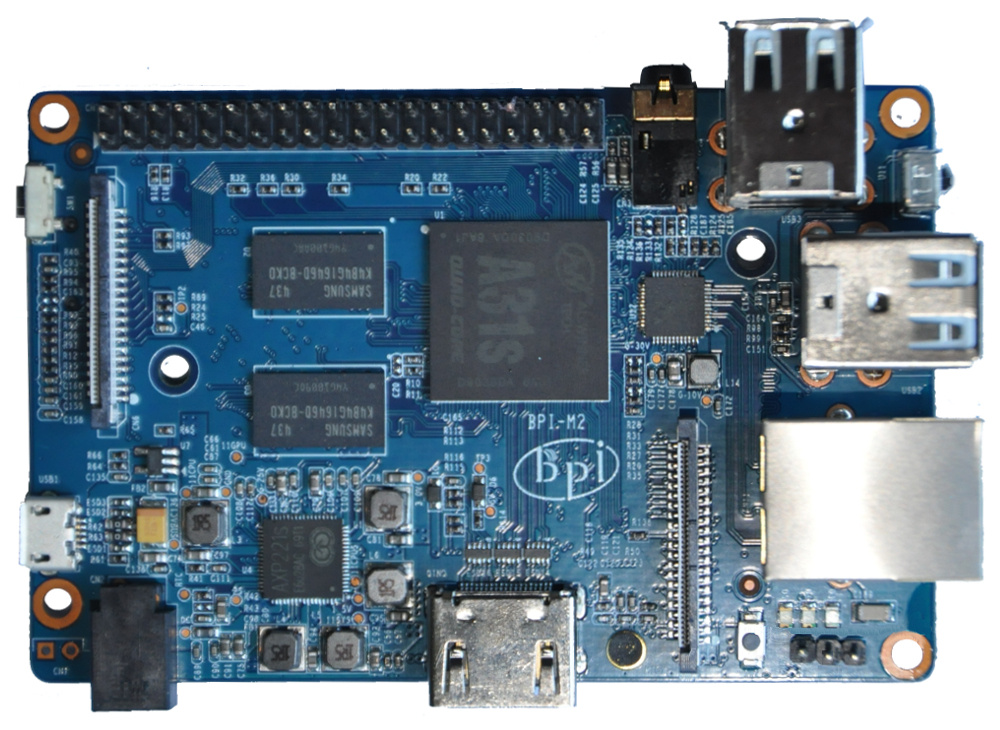
Company / Project - SinoVoip
overview from linuxgizmos
Product page
CPU - Allwinner A31 (4x Cortex-A7 @ 1.0GHz); PowerVR SGX544MP2 GPU
Memory - 1GB DDR3 RAM
Price - $ 40
The SinoVoip Banana Pi M2, priced at $ 40 on Amazon, is very similar to RPi Model B +, and is equipped with a 40-pin connector. M2 has GbE, WiFi, five USB ports, and display and camera interfaces. We removed the lower Banana Pi M2 + on Allwinner H3, with the SATA interface from our list, since it is no longer on sale. We could only find it on AliExpress in a cut-down version of the EDU for $ 22, without wireless interfaces and flash memory, and for a price ranging from $ 27 to $ 35 from various OEM vendors.
Banana Pi BPI-M2 Ultra
Company / Project - SinoVoip
overview from linuxgizmos
Product page
CPU - Allwinner R40 (4x Cortex-A7); Mali-400 MP2 GPU
Memory - 2GB DDR3 RAM; 8GB to 64GB eMMC
Price - $ 40
The Banana Pi M2 Ultra is priced at $ 40 on Amazon with shipping, but it costs $ 60 elsewhere. It has the same dimensions 92 x 60mm as the M2, but is equipped with a faster Allwinner R40, and has a SATA connector. In exchange, I had to sacrifice one of the four USB ports. 2GB RAM is installed, which is unusual for a SoC Cortex-A7. The M2 Ultra is also equipped with GbE, WiFi, Bluetooth, micro USB OTG, a 40-pin connector to support Raspberry Pi extensions, and display and camera interfaces.
Banana Pi BPI-M3
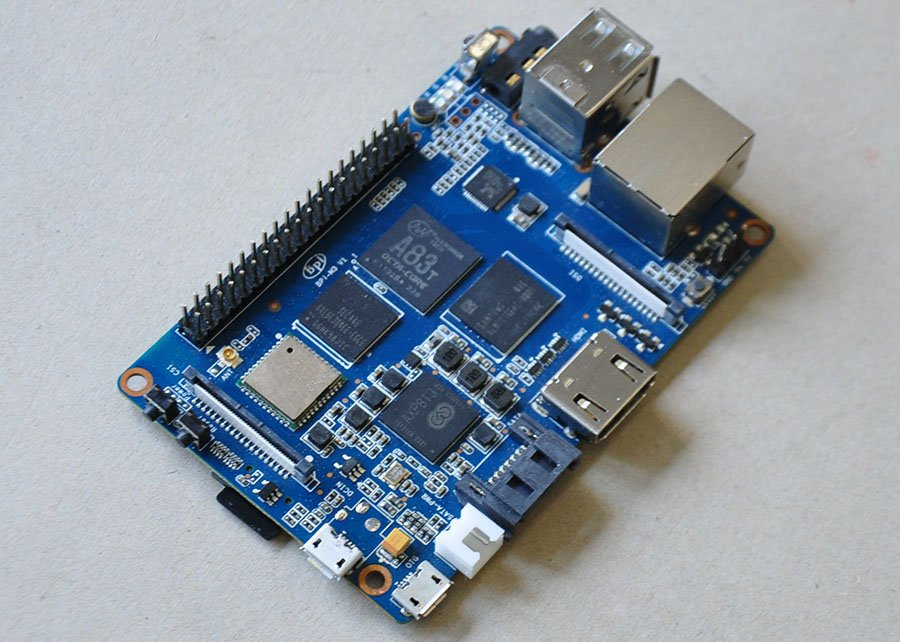
Company / Project - SinoVoip
Product page
CPU - Allwinner A83T (8x Cortex-A7 @ 1.8GHz); PowerVR SGX544MP1 GPU
Memory - 2GB LPDDR3 RAM; 8GB to 64GB eMMC
Price - $ 74
The SinoVoip Banana Pi M3 (BPI-M3) motherboard, equipped with the eight-core Allwinner A83T SoC, is sold for $ 74 on AliExpress and a dollar more on Amazon, and has 2GB RAM and 8GB eMMC. The M3 board is the same size (92 x 60mm) as the M2 Ultra, and the same RPi 40-pin connector. Like the M2 Ultra, the M3 card supports GbE, WiFi, SATA, 3x USB, and camera and display connectivity. Software support is better than other Banana Pi boards. You can choose from Android 5.1, Debian 8, Ubuntu 16.04 Mate, Raspbian Jesse Mate, Kano, Kali, CentOS, Gentoo, OpenSUSE, Arch, CRUX, and Fedora.
Banana Pi BPI-M64
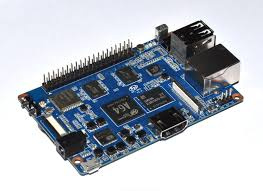
Company / Project - SinoVoip
overview from linuxgizmos
Product page
CPU - Allwinner A64 (4x Cortex-A53 @ 1.2GHz); Mali-400 MP2 GPU
Memory - 2GB DDR3 RAM; 8GB to 64GB eMMC
Price - $ 74
The first 64-bit SinoVoip Banana Pi motherboard is priced at $ 74 on AliExpress, which is more expensive than other Allwinner A64 Pine A64 motherboards, but it is equipped with 2GB RAM and rich peripherals. You get HDMI with 4K support, MIPI-DSI, and MIPI-CSI, also wireless interfaces and GbE. The board size is 92 x 60mm, 3 ports USB host, micro-USB OTG, and RPi 40-pin connector.
Banana pro
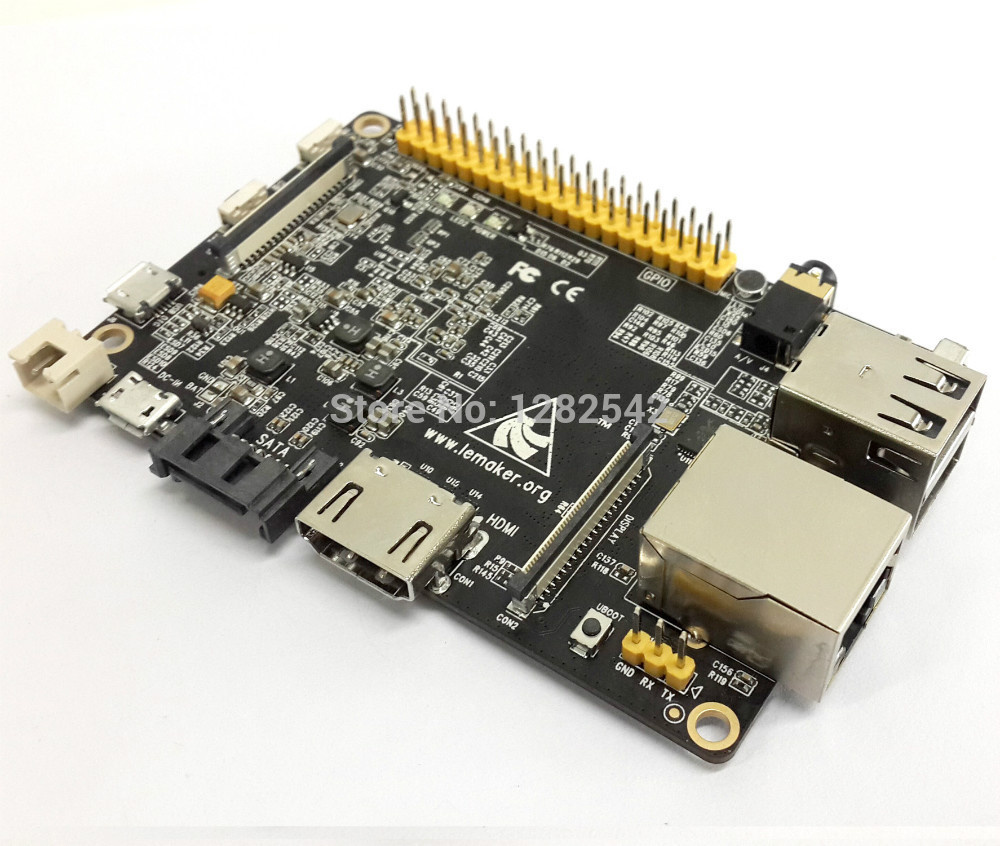
Company / Project - LeMaker
overview from linuxgizmos
Product page
CPU - Allwinner A20 (2x Cortex-A7 @ 1GHz); Mali-400 MP2 GPU
Memory - 1GB DDR3 RAM
Price - $ 48
Compared to the SinoVoip Banana Pi M2 boards, the Banana Pro board from the former SinoVoip partner, LeMaker has a dual-core SoC A20. Banana Pro has a SATA connector and a RPi-compatible 40-pin connector. There is also a microSD, WiFi, 2 USB host ports, and a micro USB OTG. LeMaker also offers a LeMaker Guitar single board, and a HiKey compatible 96Boards (see below).
BeagleBone Black, Rev C
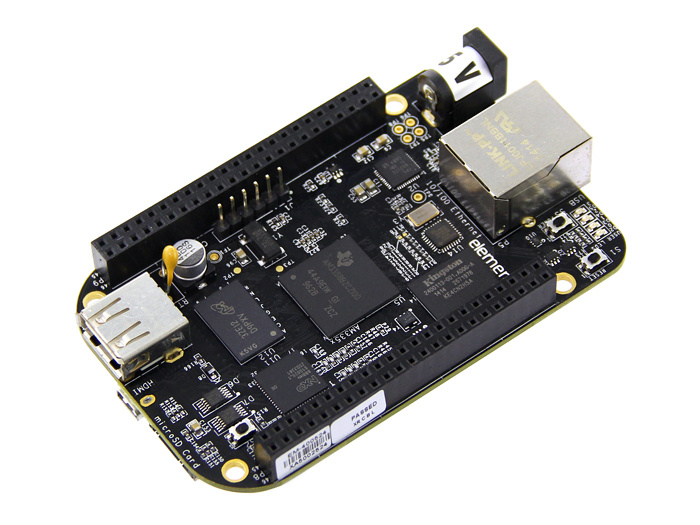
Company / Project - BeagleBoard.org
overview from linuxgizmos
Product page
CPU - TI Sitara AM3358 (1x Cortex-A8 @ 1GHz) with PRU MCU chips; PowerVR SGX530 GPU
Memory - 512MB RAM; 4GB eMMC
Price - $ 48
The Debian compatible BeagleBone Black Rev C, which ranked third out of 81 in the 2016 review, is available for purchase in many places, with the lowest price of $ 48 in MCM Electronics. The single board computer for industrial applications has many expansion interfaces and programmable microcontrollers “PRU”, also a well-developed community of BeagleBoard.org and an ecosystem. In recent years, clones authorized by BeagleBoard.org have appeared. In addition to the two BeagleBone Green models from SeeedStudio, there is also BeagleBone Black Wireless from Octavo, and BeagleBoard.org's own design, BeagleBone Blue (see below), as well as the new BeagleBone Black Industrial 4G from Element14, identical to BB Black, but varnished and having a temperature range of -20 to 85 ° C. SanCloud’s BeagleBone Enhanced board is rich in features, sent to backers from Indiegogo, and although the board’s design is open, it is no longer available. With a big delay, the dual-core BeagleBoard-X15 on the Cortex-A15 is finally available from various vendors, including the Mouser. However, it costs $ 264, and exceeds our limit of $ 200.
BeagleBone Black Wireless
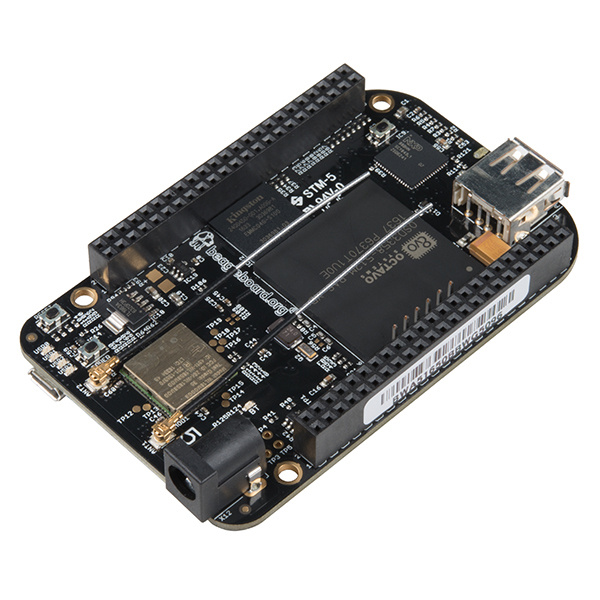
Company / project - BeagleBoard.org; Octavo Systems
overview from linuxgizmos
Product page
CPU - Octavo Systems OSD3358 SiP with TI Sitara AM3358 (1x Cortex-A8 @ 1GHz) with PRU MCUs; PowerVR SGX530 GPU
Memory - 512MB RAM; 4GB eMMC
Price - $ 68.75
With the support of BeagleBoard.org, Octavo Systems has made an alternative to Seeed's BeagleBone Green Wireless (see below), also adding 2.4GHz 802.11a / b / g / n and Bluetooth 4.1 BLE to the design of BeagleBone Black. Unlike the two BB Green models from Seeed, the BeagleBone Black Wireless retained the micro-HDMI port, like the BB Black, but lost the Ethernet port. Otherwise, it is identical to BB Black, with two exceptions: it is built on the basis of the Octavo Systems OSD3358 SiP module (system-in-package), which integrates BeagleBone functionality into one BGA package, which makes it easy to create your own designs based on it.
BeagleBone Blue

Company / Project - BeagleBoard.org
overview from linuxgizmos
Product page
CPU - Octavo Systems OSD3358 SiP with TI Sitara AM3358 (1x Cortex-A8 @ 1GHz) with PRU MCU chips and PowerVR SGX530 GPU
Memory - 512MB RAM; 4GB eMMC
Price - $ 80
The BeagleBoard.org robotic collaboration with the UCSD Coordinated Robotics Lab has built a BeagleBone clone for motion and battery power management tasks. Like BeagleBone Black Wireless, the BeagleBone Blue includes TI WiLink 8 with WiFi and Bluetooth 4.1 LE, as does the Octavo Systems OSD3358 SiP module, which contains the Sitara AM3358 SoC, RAM, and flash, as well as PMIC and other peripherals. Ethernet port and display interface are missing, but you get micro USB 2.0 host and client ports, 8 outputs for servomotors, 4 outputs for DC motors, 4 inputs for quad-encoders. There is also an IMU, barometer, JTAG, GPS and DSM2 radio. Power range 9-18V DC, connector for LiPo-battery, and the usual rich list of BB Black interfaces. Many custom buttons and LEDs are also present on the board. By default, the BeagleBone Blue works under the Debian-based real-time stack, can also work under Ubuntu Core, and supports ROS and ArduPilot.
BeagleBone Green
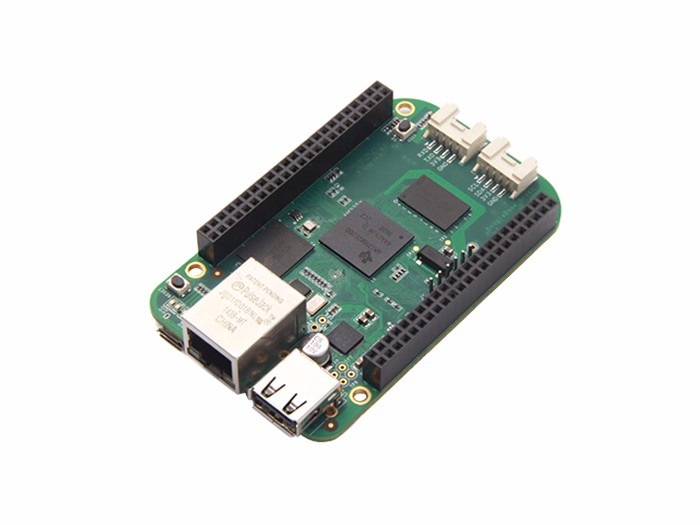
Company / project - BeagleBoard.org; Octavo Systems
overview from linuxgizmos
Product page
CPU - TI Sitara AM3358 (1x Cortex-A8 @ 1GHz) with PRU MCU chips; PowerVR SGX530 GPU
Memory - 512MB RAM; 4GB eMMC
Price - $ 39
SeeedStudio, developed with the permission of BeagleBoard.org, is designed for IoT, and is a variant of BeagleBone Black, sold for $ 39 from Banana Robotics. The BeagleBone Green board lost its micro HDMI port and 5V connector. However, it has a lower cost, and Seeed's Grove sensor connectors are installed on it. Also, the mini-USB connector is replaced with micro-USB. Seeed has its own developer site in addition to supporting the large BeagleBoard community.
BeagleBone Green Wireless

Company / project - BeagleBoard.org; Octavo Systems
overview from linuxgizmos
Product page
CPU - TI Sitara AM3358 (1x Cortex-A8 @ 1GHz) with PRU MCU chips; PowerVR SGX530 GPU
Memory - 512MB RAM; 4GB eMMC
Price - $ 49.90
The BeagleBone Green Wireless board has the same basic parameters as BB Green, with the same additions and losses compared to BB Black, including additional Grove interfaces. The Wireless model contains WiFi and Bluetooth, and three USB host ports, making it the leader in terms of USB among all the BB Black clones that exist today. The TI WiLink8 module has become standard, providing wireless connectivity via Bluetooth 4.1 LE and 2.4GHz 802.11a / b / g / n with 2 × 2 MIMO.
Bubblegum-96

Company / Project - uCRobotics
overview from linuxgizmos
Product page
CPU - Actions Semiconductor Actions S900 (4x Cortex-A53 @ 1.8GHz); PowerVR G6230 GPU
Memory - 2GB LPDDR3 RAM; 8GB eMMC
Price - $ 89
Based on the early prototype of the ActDuino S900, the uCRobotics Bubblegum-96 board complies with Linaro's 96Boards CE specifications. The Bubblegum-96 doesn't have a GPS chip like its competitor, 96Boards is a compatible DragonBoard 410c, but it has a faster SoC and twice the RAM — 2GB. In addition to the 40- and 60-pin 96Boards expansion connectors, the Bubblegum-96 board supports an HDMI port, a microSD slot, a micro USB port, and a dual USB host port, one of which is USB 3.0. There is also WiFi and Bluetooth.
Chip Pro Dev Kit
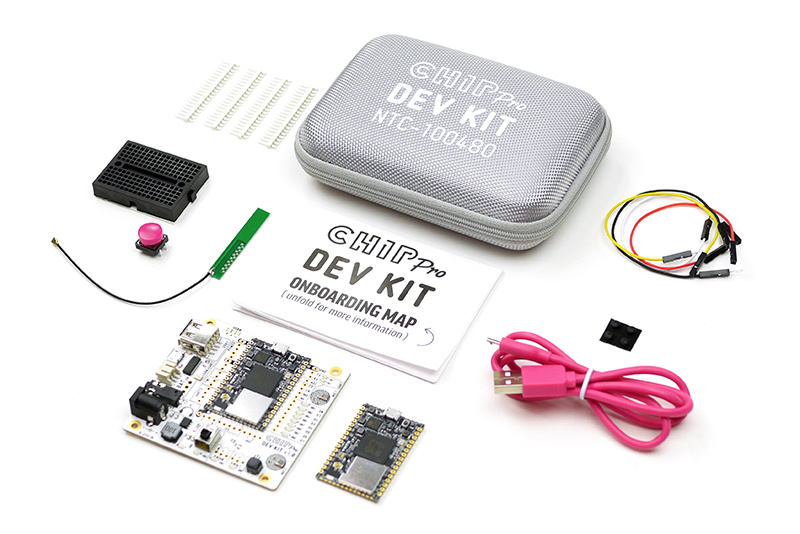
Company / Project - Next Thing Co.
LinuxGizmos coverage
Product page
CPU - Allwinner / Next Thing GR8 (1x Cortex-A8 @ 1GHz); Mali-400 GPU
Memory - 256MB or 512MB DDR3 (SiP) RAM; 512MB NAND flash
Price - $ 49
The $ 9 Chip Single Board is not currently for sale, but it will be back soon with the new GR8 SiP version of the SoC Allwinner R8. In the meantime, you can buy a sandwich (sandwich style) Chip Pro Dev Kit with two GR8 Chip Pro computers on modules, with integrated 802.11b / g / n and Bluetooth 4.2 BLE. One of these Chip-like modules is soldered to the board, the second one is attached separately. The base board has a USB 2.0 host port, a micro USB port with UART support, an audio jack, and two microphones. There is also a 6-23V DC input and a 3.7V LiPo battery input, as well as PWM, UART, and GPIO interfaces. The kit includes a miniature development board, jumpers, connectors, and a WiFi antenna. Linux support available: Buildroot and Debian. Next Thing also sells Chip-based PocketChip for $ 69 with a 4.3-inch touchscreen and keyboard.
Cloudbit

Company / Project - LittleBits Electronics
overview from linuxgizmos
Product page
CPU - NXP i.MX233 (1x ARM9 @ 454MHz)
Memory - 64MB RAM; 4GB microSD card
Price - $ 60
The only Linux board out of all LittleBits produced by Arduino. This board is one of the smallest single board, size 15 x 10mm. The CloudBit board contains WiFi, is powered via micro USB, and has two “BitSnap” connectors for adding LittleBits modules, six of which are available in the set for $ 90. The platform runs under Arch Linux, connects to the cloud platform on Node.js and is designed for different IoT gadgets, supports IFTTT scripts.
Creator Ci40

Company / Project - Imagination Technologies
overview from linuxgizmos
Product page
CPU - Imagination cXT200 (2x MIPS InterAptiv @ 550MHz)
Memory - 256MB DDR3 RAM; 512MB flash
Price - $ 85 (65 pounds), or $ 169 (130 pounds) for a full set of IoT
Imagination Technologies is trying to sell the MIPS business, and the Creator Ci40 may be the last in the lineup launched with the Creator Ci20. Boards are available at RS Electronics for £ 65. The 130 pound full IoT Kit includes several MikroBus Clicker wireless modules and a Click subsidiary of MikroElektronika. In the Ci40 board, compared to the Ci20's, the Ingenic XBurst processor is replaced by the Imagination cXT200, a slower, more energy-efficient MIPS InterAptiv chip without a GPU. Other changes include better support and MikroBus and Raspberry Pi expansion interfaces.
CubieAIO-A20
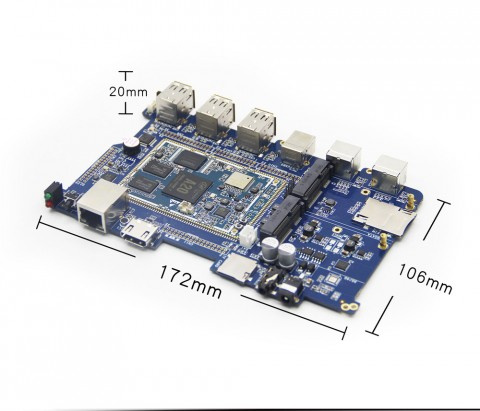
Company / Project - Cubieboard.org, CubieTech Limited
Product page
CPU - Allwinner A20 (2x Cortex-A7 @ up to 1GHz); Mali-400 MP2 GPU
Memory - 1GB DDR3 RAM; 8GB expandable flash to 32GB (eMMC) or 64GB (TSD)
Price - $ 122
We removed the Cubieboard 3 board from the review, since it is old, expensive ($ 100), and is not currently for sale, and replaced it with another board on the Allwinner A20. The CubieAIO-A20 is remarkable in that it offers 6 USB 2.0 host and micro USB OTG ports, two UART serial ports, and a DIN connector, expandable to 6 serial ports via an expansion card. Such a composite (sandwich-style) board includes a CubieTech Einstein-A20 COM module with a size of 75 x 50mm, which is equipped with WiFi, Bluetooth 4.0, RTC, a 200-pin expansion connector, and its own micro USB port. The COM singleplatform module supports the same Linux and Android distributions as Cubieboard 2 and 3. Like COM, the CubieAIO-A20 singleplatelet has a size of 172 x 106mm, is sold for $ 122 on Amazon, and operates in a temperature range of -20 to 70 ° C . It has a GbE port, a dual mini-PCIe slot with mSATA support and 3G or 4G modules. There is also a SIM slot and an antenna for a standard WiFi / BT module. There is also a microSD, IR, HDMI, VGA, SPDIF 3.5mm audio, and a 54-pin expansion connector. The CubieAIO-A20 board is also sold in a package (mini-PC version). The AIO model costs $ 20 more, has a built-in 7-inch, 1024 x 600 display with a capacitive sensor.
Cubieboard4
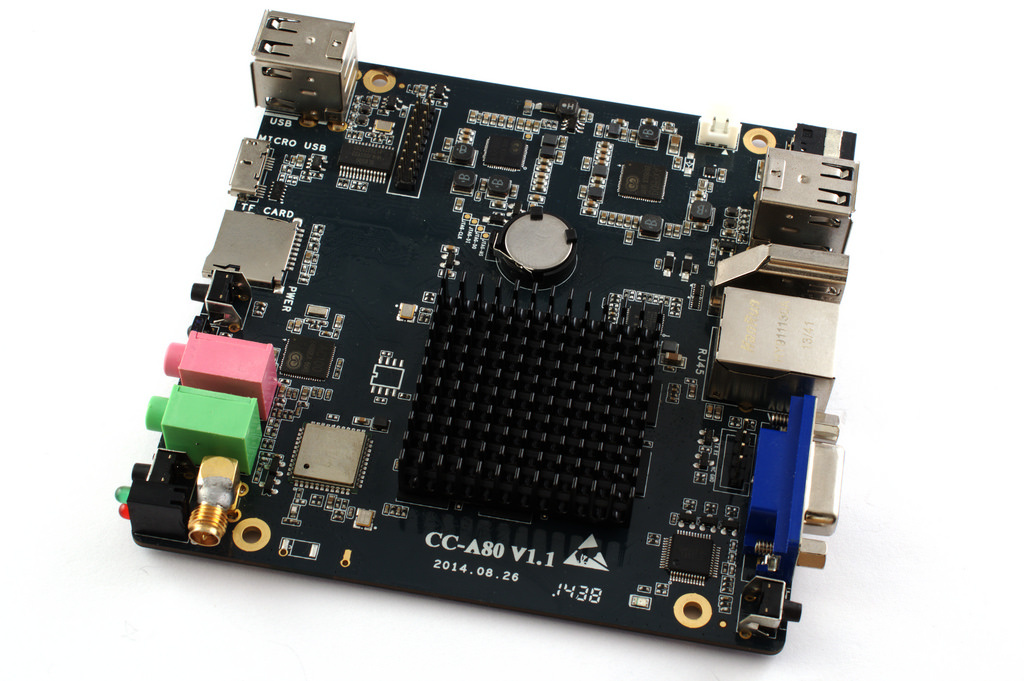
Company / Project - Cubieboard.org, CubieTech Limited
overview from linuxgizmos
Product page
CPU - Allwinner A80 (4x Cortex-A15 @ up to 2GHz, 4x Cortex-A7 @ up to 1.3GHz); PowerVR G6230 GPU
Memory - 2GB DDR3 RAM; 8GB eMMC, expandable to 64GB
Price - $ 120
The Cubieboard4 is equipped with an eight-core Allwinner A80 SoC with a 64-core PowerVR G6230 GPU. The 111 x 111mm singleplate has WiFi, Bluetooth, GbE, VGA, HDMI, USB 3.0, and 4 USB 2.0 ports. There is also a 54-pin expansion slot. A single board has (optionally) two microSD slots, or one microSD and flash memory. There are many packages and extensions for Cubieboards, images for Debian, Linaro Ubuntu 14.04, and Android 4.4.
Cubieboard5 (CubieTruck-Plus)
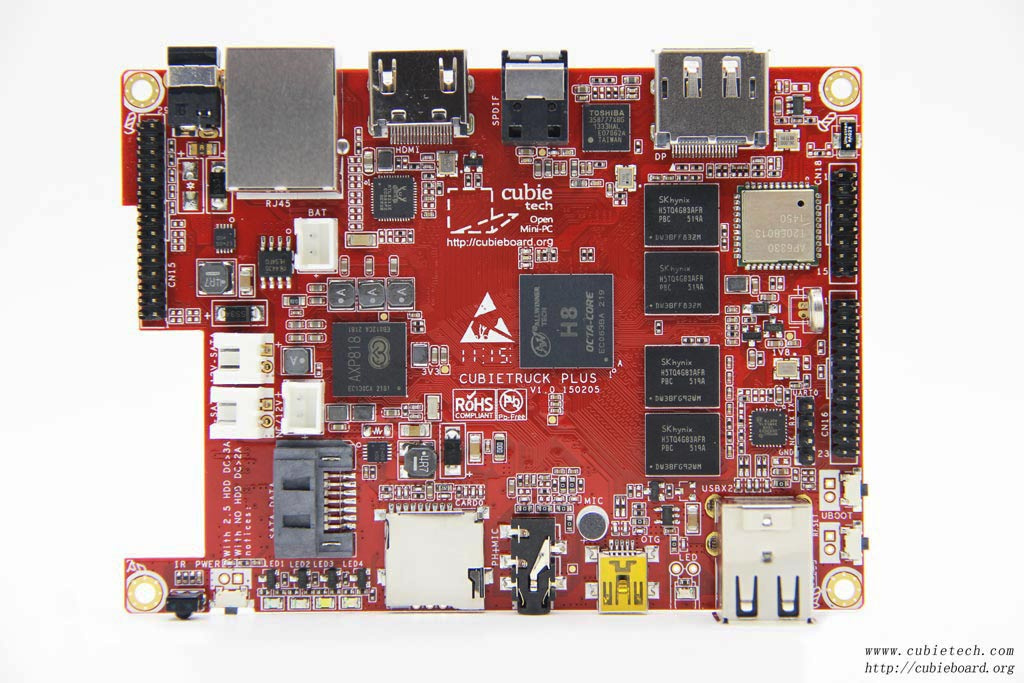
Company / Project - Cubieboard.org, CubieTech Limited
Product page
CPU - Allwinner H8 (8x Cortex-A7 @ up to 2GHz); PowerVR SGX544 GPU @ up to 700MHz
Memory - 2GB DDR3 RAM
Price - $ 99
The CubieBoard5 is equipped with an Allwinner H8w processor with eight Cortex-A7 cores. Odnoplatnik has microSD and SATA, with an optional expansion card for RAID. For communication, there is WiFi, Bluetooth 4.0, and a GbE port. Two displays are supported, via HDMI and DisplayPorts. There are also two USB host ports, IR, S / PDIF audio, and an optional lithium battery.
To be continued
All Articles